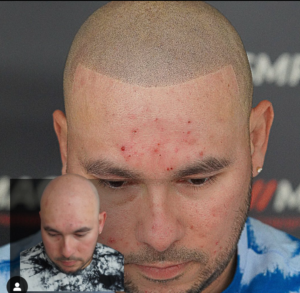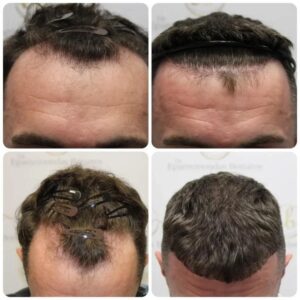Bald patches on the head can be a distressing experience for anyone, impacting self-esteem and overall confidence. Understanding the underlying causes and effective treatments is crucial for managing and preventing this condition. Studies show that approximately 50 million men and 30 million women in the United States experience hair loss, with bald patches being a common manifestation.
Bald patches, medically known as alopecia areata, can occur for various reasons, including genetic predisposition, hormonal changes, stress, and certain medical conditions. The National Alopecia Areata Foundation states that this condition affects around 2% of the population at some point in their lives. These patches can appear suddenly and vary in size, causing significant distress to those affected.
This blog post will explore the reasons behind bald patches, considering factors such as sex, age, and race. We’ll also delve into natural treatments and prevention methods to help you maintain a healthy scalp. Whether you’re experiencing hair loss yourself or seeking information for a loved one, this guide aims to provide comprehensive insights and practical solutions.

Image Credit: Pexels
Table of Contents
Key Takeaway
Bald patches on the head can occur for various reasons, including genetic factors, autoimmune conditions, stress, and hormonal changes. Both men and women can experience bald patches, although the patterns and causes may differ. With unique contributing factors, children and people of different races and ethnicities can also be affected.
Natural treatments like essential oils, aloe vera, massage, and peppermint oil can help manage bald patches. Preventative measures include maintaining a healthy diet, reducing stress, and using gentle hair care products. Understanding the root cause is key to effective treatment and prevention.
Why Do Bald Patches on the Head Occur?
Bald patches, also known as alopecia, can result from several underlying conditions:
- Genetics: Hereditary factors are significant, particularly in conditions like androgenetic alopecia.
- Autoimmune Disorders: Conditions like alopecia areata cause the immune system to attack hair follicles, leading to hair loss.
- Hormonal Changes: Hormonal imbalances, especially related to thyroid issues, can cause bald patches.
- Stress: Physical or emotional stress, known as telogen effluvium, can lead to temporary hair loss.
- Infections: Scalp infections like ringworm can cause bald patches.
- Nutritional Deficiencies: Lack of essential nutrients such as iron and vitamins can impact hair health.
Bald Patches on the Head Based on Sex (Men and Women)
Bald patches and different forms of hair loss appear in different patterns depending on gender. Here is a look at what this entails for men and women:
● Men
Men are more prone to androgenetic alopecia, commonly known as male-pattern baldness. This condition, which is largely influenced by genetics and hormones, typically starts with a receding hairline and thinning at the crown.
● Women
Women may experience hair thinning across the scalp, often due to hormonal changes such as those occurring during pregnancy, menopause, or conditions like polycystic ovary syndrome (PCOS). Female-pattern baldness manifests as a general thinning rather than distinct bald patches.

Image Credit: Pexels
Bald Patches on the Head in Children
Kids are also vulnerable to bald patches on the head. Studies have shown that the common reason for this condition is Alopecia areata. However, children can develop bald patches due to several reasons:

Image Credits: Pexels
1. Alopecia Areata: An autoimmune disorder leading to patchy hair loss.
2. Tinea Capitis: A fungal scalp infection, more common in children.
3. Trichotillomania: A psychological condition where children pull out their hair due to stress or anxiety.
4. Nutritional Deficiencies: Inadequate intake of vitamins and minerals essential for hair growth. Here is a comprehensive guide on nutritional deficiency hair loss.
Bald Patches Based on Race and Ethnicity
The occurrence and pattern of bald patches can vary among different races and ethnicities due to genetic and cultural factors. Regardless, other behavioral, genetic, and environmental factors can be vital. This point may also depend on access to good healthcare centers.
While these are all true, research has revealed that African American females in the US are more vulnerable to alopecia areata compared to white females. Hispanic women are also more likely to get diagnoses compared to their Caucasian counterparts.
Some popular cultural practices can also play a vital part, as shown below:
1. Caucasians: More likely to experience androgenetic alopecia.
2. Africans: Higher incidence of traction alopecia due to certain hairstyling practices like tight braids.
3. Asians: Generally have lower rates of androgenetic alopecia but may experience other types of hair loss.
Natural Treatments for Bald Patches
Although there are medical treatments for bald patches on the head, we will explore a few natural solutions to this condition:
Essential Oils
Essential oils such as rosemary, lavender, and thyme have been shown to promote hair growth and improve scalp health. They can be diluted with carrier oils and massaged into the scalp.
Aloe Vera
Aloe vera has anti-inflammatory properties that can soothe the scalp and reduce hair loss. Applying aloe vera gel directly to the scalp can promote a healthy environment for hair growth.
Massage
Scalp massage can improve blood circulation to hair follicles, encouraging hair growth. Regular massage with oils like coconut or olive oil can be beneficial.
Peppermint Oil
Peppermint oil has been found to increase blood flow to the scalp, potentially stimulating hair growth. Patients should dilute it with a carrier oil before application.
These natural solutions can take time or be ineffective in some stages of baldness. However, other efficient methods, including scalp micropigmentation, medications, and hair transplants, can improve the appearance of hair.
Prevention of Bald Patches on the Head
- Healthy Diet: Ensure a balanced diet rich in vitamins and minerals essential for hair health, such as iron, zinc, and vitamins A, C, D, and E.
- Stress Management: Practice stress-reducing techniques like meditation, yoga, or regular exercise.
- Gentle Hair Care: Avoid harsh hair treatments and styles that pull on the hair. Use gentle, sulfate-free shampoos and conditioners.
- Regular Check-ups: Monitor and address any underlying health conditions with the help of a healthcare provider.
Frequently Asked Questions and Answers
1. Can stress cause bald patches?
Yes, physical or emotional stress can trigger telogen effluvium, a type of hair loss that leads to bald patches. This has been proven by research.
2. Are bald patches permanent?
It depends on the cause. Some conditions, like alopecia areata, can lead to temporary hair loss, while others, like androgenetic alopecia, can be permanent.
3. Can diet impact hair loss?
Yes, nutritional deficiencies can contribute to hair loss. A balanced diet rich in essential nutrients is crucial for healthy hair.
4. Is hair regrowth possible with natural treatments?
Natural treatments like essential oils, aloe vera, and scalp massage can promote hair regrowth, especially when used consistently.
5. When should I see a doctor for bald patches?
If you notice sudden or excessive hair loss, it’s essential to consult a healthcare provider to determine the underlying cause and appropriate treatment.
Wrapping Up
Various factors, including genetics, autoimmune disorders, hormonal changes, and stress, can cause bald patches on the head. Understanding these causes is key to effective treatment and prevention.
Natural remedies and lifestyle changes can help manage and reduce hair loss, promoting a healthier scalp. If you’re experiencing bald patches, consider consulting a healthcare provider to identify the root cause and explore the best treatment options.
Want to explore our non-surgical hair loss treatment at Mac SMP? Click here to book your free consultation.
Enjoy This Article? You May Also Like:
- Why is your Hair Dropping Out? Common Causes and Solutions at Mac SMP
- Achieving a Full Head of Hair with Surgical Hair Implants
- Alopecia baldness explained: Causes, treatments, and How Mac SMP can Help
- Balding Hair: Myths Vs. Facts And Effective Strategies To Combat It
- Hair Loss Thinning: Causes, Prevention And Treatment Options




